Updated: 25-Nov-2020
The Panhard et Levassor factory began building cars in 1894.
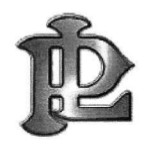
“Panhard-Levassor logo”
-The logo shown includes the two initials of René Panhard and Emile Levassor.
-When Levassor died in 1897, Arthur Krebs, a well-known balloonist and military officer who, together with Charles Renard, made the electric motor that propelled the "La France" airship.
-Between 1901 and 1903 they built 1, 2 and 4 cylinder engines ranging from 3 to 65 CV, but only for the propulsion of cars and boats.
-To identify them, they use the number of the cylinders and a letter, such as 2E or 4E.
-Between 1903 and 1908 they made another new generation of engines that was identified with numbers and letters, some of them repeated from those of the first generation, for example the 4E.
-In 1905 a 45 CV car engine is adapted to power airships.
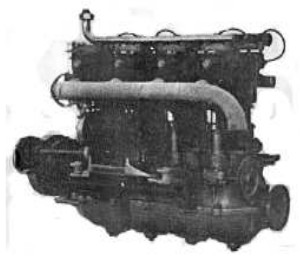
“Panhard et Levassor engine from 1906”

“Panhard et Levassor from 1906 at the MAE”
-We see another model of the same year. The engines of that time had a copper outer cylinder jacket (cuivre rouge) that gave them a magnificent appearance.
-The powers were low, 45 CV in 1907 was common.
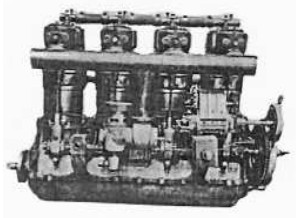
“Panhard et Levassor from 1907”
-They continued to manufacture engines, especially for airships. It seems that the next one already gave 125 CV
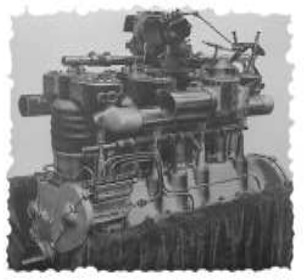
“Panhard et Levassor de 125 CV”
-It is quite possible that the 1909 125 CV engine was the one installed on the “La Chausé” airship.
-The first Panhard et Levassor engine applied to an aircraft seems to be the 35 CV, four-cylinder engine, mounted on the Tellier airplane.
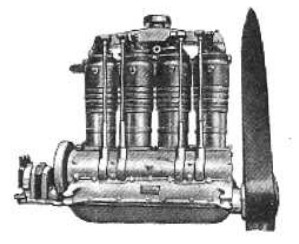

“Panhard et Levassor from 1910”
-In the first flight, the pilot M. Dubonnet took off from Juvisy and landed in Orleans. The engine was similar to those of ordinary cars, it differed only in distribution. It had steel cylinders and copper outer jackets welded to the cylinders.
-It was considered "Monosoupape" for having a single valve in each cylinder head, with a rocker arm and a control rod, as we would later see in the Gnome Monosoupape, with differences.
-The Panhard et Levassor valve was double and concentric, opening intake or exhaust depending on the stroke.

“Double valve details”
-Between 1909 and 1912 the following aviation engines stood out:
-The 4I, 5320 cc and 35-40 CV.
-The 6I, 7980 cc and 55 CV.
-The 6J, 9500 cc and 65 CV.
-In these years Panhard required the Charles Yale Knight license for valveless engines with sliding sleeves.
-In 1912 a third generation of engines was produced that included the “Centauro” family from 1908 to 1914.
-From the small 1I that gave 7 CV to the 16Y that delivered almost 700 CV.
-The 4Es (again), and 4F, R, L, I, M, O and V, or the 6S. For example, those with 6 cylinders between 80 and 120 CV were those carried by the airships España and Liberté.
-In 1914 the factory is intervened to proceed to the manufacture of military material only, which included aviation engines.
-In 1915 they started to build 12-cylinder Vee-engines: the 230 CV or the V12CB and 350 CV of 1916.

“Panhard et Levassor, 12 cylinder Vee, 230 CV”
-The 350 CV was delivered at 1,800 rpm. This engine started its way with 240 CV rotating at 1,350 rpm. By increasing the rotation speed and compression to 5.3 to 1, the power of 350 CV was obtained. (V12-CB).

"Panhard et Levassor, 350 CV"
-The Type V12-CB, had its cylinders with a bore of 115 mm and a stroke of 170 mm.
-It had a gearbox with a 25/45 gear ratio.
-It had two of Panhard et Levassor's own carburetors, four magnetos, two spark plugs per cylinder and one exhaust valve and one intake valve per cylinder.
-The V12-J gave 500 CV. A right front view of this engine is shown below, very clear.
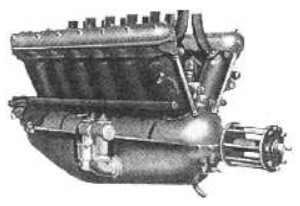
“Panhard et Levassor V12-J”
-Another engine was the water-cooled 200 CV V-8, with very clean lines.
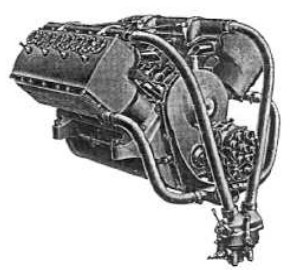
“Panhard et Levassor V-8”
-Tests were made with formulas of 12 cylinders in W giving 600 CV at 1,650 rpm. It seems that they did not prosper.

“Panhard et Levassor V-8”
-There was another 16-cylinder, a double-Vee engine (not the same as W) that gave 650 CV.
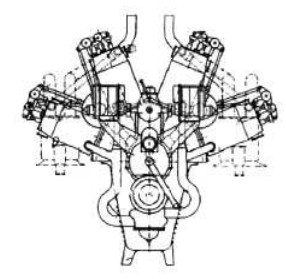
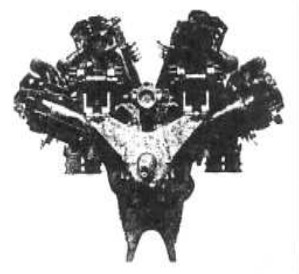
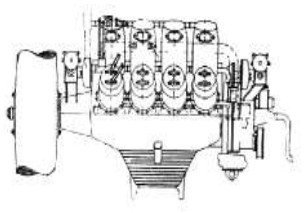
“Schematic drawings and silhouette of 16 cyl. double Vee"
-Another engine that broke concepts was the 12L that was valveless with extremely short cylinder heads. It used the Knight mechanism (Remember that Bristol used the Burt-McCollum system). This engine gave 500 CV.

“Knight sleeves”
-The sleeves that we see go one inside the other and go up and down driven by a connecting rod attached to the lower eyelets, according to the strokes.
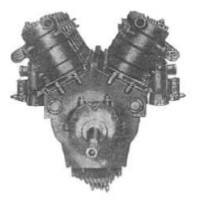

“12L front and side view”
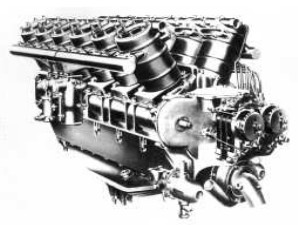
"Nice view of the 12L"
-The V12-M shown below gave 600 CV, and followed the classic 12V line with 4 valves per cylinder.

“V12-M”
-At the 1926 Paris Motor Show two new Panhard et Levassor engines are shown. They are known as the 500 CV Super-compressed obtaining a maximum altitude of 3,000 meters (equivalent to 750 CV).
-The V formed by the cylinder blocks was at 60°.
-The other engine presented in Paris was the “valveless” (12L). It was the one that took part in the “Great Endurance” contest the previous year, finishing second. It gave 525 CV.

“500 CV, overcompressed”

“500 CV, overcompressed”
-Before completing this stage as a manufacturer of aviation engines, in 1934, they built several Clerget 14F2 Diesel radial engines.
-As in an addendum we add more recently arrived information. We obtained a better view of the 16 cylinder Panhard et Levassor, the model was a double Vee or rather two coupled V-8 engines with the use of a single crankshaft. It was intended for 700 CV at 1,700 rpm.
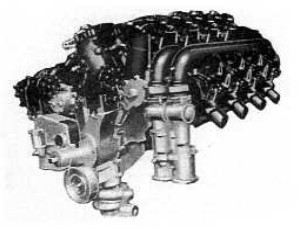
“Panhard et Levassor, 16 double Vee”
-In 1928 Panhard et Levassor made the first diesel engine designed by Clerget: a 9-cylinder radial with a displacement of only 806 cu. in. and 100 CV of power.
-It seems that there was another larger one that delivered over 200 CV.
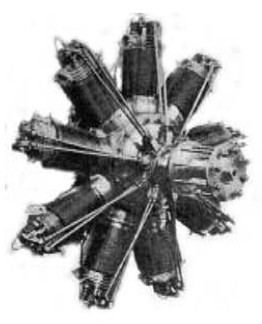
“Panhard-Levassor / Clerget”
-At the MAE engine reserve store there is a four-cylinder Panhard et Levassor engine.
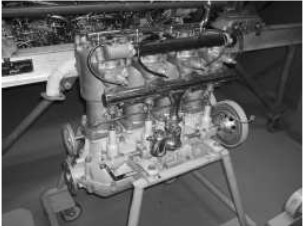
“Four-cylinder Panhard et Levassor engine”
-This engine is beautifully restored with red copper (cuivre rouge) ducts and extremely shiny carburetor parts.
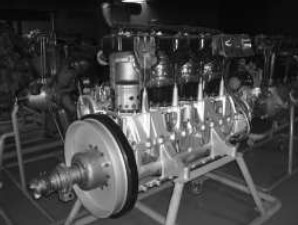
"Another Panhard et Levassor at the MAE reserve store, 4 cylinders"
-An engine newly arrived at the aforementioned warehouse is the Panhard et Levassor-Clerget, like the one that appears above.
-It is a small nine cylinder radial running on the Diesel system.

“Panhard et Levassor - Clerget”
-We can see the small individual injection pumps at each cylinder foot.
-In a newspaper library we found a 6-cylinder Panhard installed on board the Tellier monoplane.

"The 6-cylinder on board" (PiP)
From Appendix 10: In an old Flight magazine there is a photograph - and some information - of the 1910 vertical four-cylinder engine. It is the 4L model that gave 35 CV.
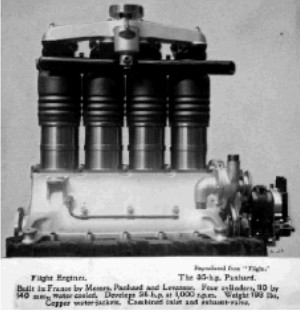
“Panhard-Levassor type 4L”
-From the same magazine but from another year, the 120 CV engine.
-This same engine on the same wooden frame lined with “velvet” fabric is described in the main text with 125 CV.
-But this issue is not decisive since 50 rpm more or less due to aircraft or propeller design, the power of the same engine can already vary by 5 CV.
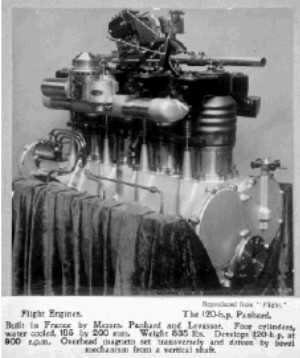
"Panhard et Levassor, 120 CV"
-New photo of the V8 that gave 100 CV.

"Rear view of the Panhard et Levassor 100 CV with propeller"
-We located an illustration of the 16-cylinder, double-Vee engine, or VV. In fact they are two V8 engines placed side by side around a single crankshaft.

“Panhard et Levassor 16VV”
Engines of PANHARD et LEVASSOR
Model: 1-E, 2-3 CV
Arquitecture: Single-cylinder
Cooling:
Total Displacement:
Bore / Stroke:
Power: 3 CV
Weight:
Model: 1-I, 4-7 CV
Arquitecture: Single-cylinder
Cooling:
Total Displacement:
Bore / Stroke:
Power: 7 CV
Weight:
Model: 12-CB, 350 CV
Arquitecture: 12-cylinder V-Engine
Cooling:
Total Displacement:
Bore / Stroke:
Power: 350 CV
Weight:
Model: 12-J, 220 CV
Arquitecture: 12-cylinder V-Engine
Cooling:
Total Displacement:
Bore / Stroke:
Power: 220 CV
Weight:
Model: 12-L, 450-550 CV
Arquitecture: 12-cylinder V-Engine
Cooling:
Total Displacement:
Bore / Stroke:
Power: 550 CV
Weight:

"Nice look of the Panhard et Levassor 12L"
Model: 12-M, 500 CV
Arquitecture: V-Engine
Cooling:
Total Displacement:
Bore / Stroke:
Power: 500 CV
Weight:

"Panhard et Levassor, V12-M"
Model: 12-W, 525 HP
Arquitecture: 12-cylinder W-engine
Cooling:
Total Displacement:
Bore / Stroke:
Power: 600 CV @ 1650 rpm
Weight:
Model: 16-W, 650 CV (doble V)
Arquitecture: W-engine
Cooling:
Total Displacement:
Bore / Stroke:
Power: 650 CV
Weight:
Double Vee
Model: 16-Y, 700 HP
Arquitecture:
Cooling:
Total Displacement:
Bore / Stroke: x
Power:
Weight:
Model: 2-E, 5 CV
Arquitecture: 2-cylinder In-line
Cooling:
Total Displacement:
Bore / Stroke:
Power: 5 CV
Weight:
Model: 2-I, 12-15 CV
Arquitecture: 2-cylinder In-line
Cooling:
Total Displacement:
Bore / Stroke:
Power: 15 CV
Weight:
Model: 2-R, 7 CV
Arquitecture: 2-cylinder In-line
Cooling:
Total Displacement:
Bore / Stroke:
Power: 7 CV
Weight:
Model: 3-E, 8 CV
Arquitecture: 3-cylinder In-line
Cooling:
Total Displacement:
Bore / Stroke:
Power: 8 CV
Weight:
Model: 4-E, 10 CV
Arquitecture: 4-cylinder In-line
Cooling:
Total Displacement:
Bore / Stroke:
Power: 10 CV
Weight:
Model: 4-F, 16-18 CV
Arquitecture: 4-cylinder In-line
Cooling:
Total Displacement:
Bore / Stroke:
Power: 18 CV
Weight:
Model: 4-I, 20-24/35-40 CV
Arquitecture: 4-cylinder In-line
Cooling:
Total Displacement:
Bore / Stroke:
Power: 40 CV
Weight:
Model: 4-L, 30/35 CV
Arquitecture: 4-cylinder In-line
Cooling:
Total Displacement:
Bore / Stroke:
Power: 35 CV
Weight:

"Panhard-Levassor type 4L"
Model: 4-M, 60-65/70/80-90/120 CV
Arquitecture: 4-cylinder In-line
Cooling:
Total Displacement:
Bore / Stroke:
Power: 120 CV
Weight:
Model: 4-R, 15 CV
Arquitecture: 4-cylinder In-line
Cooling:
Total Displacement:
Bore / Stroke:
Power: 15 HP
Weight:
Model: 4-V, 65 CV
Arquitecture: 4-cylinder
Cooling:
Total Displacement:
Bore / Stroke:
Power: 65 CV
Weight:
Model: 6-I, 55 CV
Arquitecture: 6-cylinder In-line
Cooling:
Total Displacement:
Bore / Stroke:
Power: 55
Weight:
Model: 6-J, 65 CV
Arquitecture: 6-cylinder In-line
Cooling:
Total Displacement:
Bore / Stroke:
Power: 65 CV
Weight:
Model: 6-M, 130 CV
Arquitecture: 6-cylinder In-line
Cooling:
Total Displacement:
Bore / Stroke:
Power: 130 CV
Weight:
Model: 6-S, 65 CV
Arquitecture: 6-cylinder In-line
Cooling:
Total Displacement:
Bore / Stroke:
Power: 65 CV
Weight:
Model: 8-M, 180 CV
Arquitecture: V-Engine
Cooling:
Total Displacement:
Bore / Stroke:
Power: 180 CV
Weight:
Model: K-122
Arquitecture:
Cooling:
Total Displacement:
Bore / Stroke: x
Power:
Weight:
Model: V8, 100 CV
Arquitecture: 8-cylinder V-Engine
Cooling:
Total Displacement:
Bore / Stroke:
Power: 100 CV
Weight:
Model: V8, 200 CV
Arquitecture: 8-cylinder V-Engine
Cooling:
Total Displacement:
Bore / Stroke:
Power: 200 CV
Weight:
Model: VK-12L, 485 CV (K-122)
Arquitecture: 12-cylinder V-Engine
Cooling:
Total Displacement:
Bore / Stroke:
Power: 485 CV
Weight:


